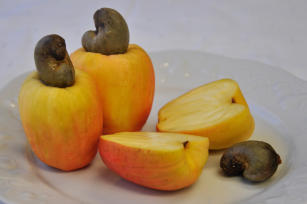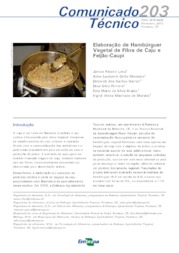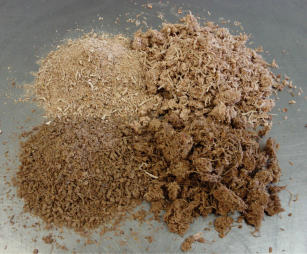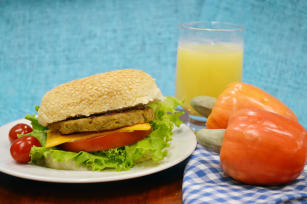Laboratory-processed cashew fiber prevents obesity in animals
Laboratory-processed cashew fiber prevents obesity in animals
Cashew bagasse fibers which had its sugars and other low molecular weight compounds extracted in laboratory were able to inhibit obesity in rats on a high-calorie diet. The animals were under a high-fat diet for 15 weeks. Some of the animals also received the laboratory-processed fiber. The result encouraged scientists from Embrapa Tropical Agroindustry and from the Federal University of Ceará (UFC), who conducted the research.
The fiber controlled their weight, abdominal fat, appetite and prevented high blood glucose, blood insulin rates and blood fat (triglycerides). It also prevented inflammation and reduced the liver injury caused by the high-calorie diet.
Obesity causes the organism to start presenting resistance to the hormones that control satiety, making the individual to feel hungrier, according to the nutritionist Diana Valesca Carvalho, UFC professor and responsible for the experiment. In the study, although the animals were on a high-calorie diet, they maintained normal levels of leptin and insulin but reduced grelin - the hormone related to hunger, all of which entailed satiety control.
Using the nuclear magnetic resonance (NMR) technique, the researchers found out that there were short-chain fatty acids in the serum and feces of the animals that consumed the processed fiber. The presence of these fatty acids is associated with the control of satiety and the promotion of the growth of beneficial bacterial flora, which helps control body weight. "Probably all of the effects that the fiber has had on the prevention of obesity in the animals are due to the production of short-chain fatty acids.” says Diana Carvalho.
What are short chain-fatty acids and why are they good for your health?The human body does not digest plant fibers. Some bacteria in the intestine ferment these fibers to obtain energy and nutrients, releasing short-chain fatty acids, simple molecules composed of a chain of one to five carbon atoms and a carboxyl group. These compounds, mainly acetate, propionate and butyrate, are absorbed by gut cells, accounting for up to 90% of all the energy they consumed. Several beneficial effects are attributed to the fermentation and production process of these compounds, such as reducing the risk of developing cancer, diabetes, inflammatory bowel diseases, and even psychiatric disorders. |
She clarifies that the presence of these acids means that the fiber has fermented in the intestine. The finding is relevant because 80% of the cashew fiber is insoluble and scientific studies usually associate soluble fibers with this type of fermentation. "We expect to evaluate the effects of this fiber on the gut microbiota in the future.” he said. According to the professor, the potential effect of the fiber on the prevention of human obesity should also be evaluated in upcoming studies.
Room for fruit fibers
"There are just a few studies on fruit fibers, especially as ingredients. The great majority of the knowledge is about cereal fiber. It's a whole world of possibilities.” explains Embrapa Tropical Agroindustry researcher Edy Brito. He coordinates the Chemistry of Natural Products Multi-user Laboratory, where chemical tests with cashew bagasse were carried out.
According to Brito, the goal is to develop a new ingredient for the food industry, from a regional raw material with good functional and nutritional potential.
Processed vs. whole fiber
In the first phase of the research scientists evaluated the consumption of whole cashew bagasse without the removal of low molecular weight compounds. The results were quite different. In animals on a normal diet, the whole fiber altered the metabolism of lipids by increasing cholesterol and triglycerides.
When low molecular weight compounds were excluded in a normal-calorie diet, the effect was different, with reduced blood glucose, insulin and grelin. The metabolism of lipids in animals remained unchanged. Based on results, the researchers decided to use the processed fiber in animals on the high-calorie diet.
According to researcher Diana Carvalho, it is likely the whole fiber did not have present good results due to the high fructose - fruit sugar - levels. "Fructose is closely related to high abdominal fat. We observed high abdominal fat in the group that consumed the fiber in its whole form", she states.
According to the researcher, the studies demonstrate that whole cashew bagasse should be consumed with caution. "In order to have a functional effect on weight reduction, fiber must be processed", she stresses. The animal studies were supported by professor Flavia Almeida Santos from UFC's Department of Physiology and Pharmacology.
Cashew chemistry
The study results are part of an effort to develop high value-added products from the cashew. At Embrapa Tropical Agroindustry, several studies related to the topic are carried out and the better utilization of the cashew bagasse is one of them, since there is a significant waste of residue in the juice industry.
Among the results already obtained is the development of a concentrated extract of carotenoids. Because of its intense yellow color, the product is believed to be a potential substitute for artificial food colorants in food industry. Another work performed was the characterization of cashew bagasse fibers, an important step for use in the food industry.
The Chemistry of Natural Products Multi-user Laboratory took part in all of those studies. It is dedicated to the discovery of new bioactive molecules, to the study of species producing active principles for functional foods, drugs, bio-control agents and more.
The Chemistry of Natural Products Multi-user Laboratory based in Embrapa Tropical Agroindustry (Ceará, Brazil), with an area of 850 m² for the extraction, fractionation, isolation, quantification and identification of natural and synthetic chemical compounds. It has liquid and gas chromatography equipment, nuclear magnetic resonance, mass and infrared spectrophotometers. The laboratory also has a pilot plant for extraction and purification of volatile compounds.
Photo: Claudio Noroes
Verônica Freire (MTb 01225/CE)
Embrapa Tropical Agroindustry
Press inquiries
agroindustria-tropical.imprensa@embrapa.br
Phone number: +55 85 3391-7116
Further information on the topic
Citizen Attention Service (SAC)
www.embrapa.br/contact-us/sac/






